The financial close used to be a finish line. Today; it’s a delay.
Reactive reporting no longer works. Especially today where cash is king, capital is constrained, and boardrooms demand cash flow predictability.
A recent survey found that nearly 70% of senior finance executives made significant business decisions based on inaccurate or incomplete financial reports. Pardon the exaggerated metaphor - but; that’s a recipe for disaster.
You can’t afford to wait until the end of the month to understand why cash flow dipped, why DSO jumped, or why collections slowed down.
Real-time analytics, especially across Accounts Receivable (AR) is no longer a future-state vision. It’s a foundational requirement of accounts receivable automation.
Why Traditional AR Reporting No Longer Cuts It
AR makes up a significant portion of current assets in most B2B businesses. Yet for many finance teams, visibility into AR is disconnected, delayed, and descriptive at best.
Reports are built retroactively - often siloed across ERP exports, spreadsheets, or BI dashboards that lack AR-specific context.
What does this lead to?
- Surprises in cash flow
- Inability to prioritize collections based on risk
- Missed DSO targets without early warnings
- Repetitive follow-ups with no visibility into their effectiveness
Meanwhile: The economic environment is unforgiving. Credit markets are tighter. Sales cycles are longer. Finance is being asked to do more with less margin for error.
As CFOs or finance leaders; you are no longer just stewards of cost. You are guardians of liquidity, partners to sales, and strategic voices to the CEO and Board.
And; this needs you to have access to real-time intelligence across AR, not just backward-looking reports.
What the Modern CFO Needs from AR Reporting
This isn't about digitizing existing reports. It’s about transforming reporting into a living, decision-ready control system. Here are the five capabilities that matter most, and why.
1. Predictive Cash Flow Insights: Observe, Analyze, and Act
Traditional forecasts assume every invoice will be paid on time. Reality rarely follows that model.
Modern AR analytics should layer in behavioral signals, on how a customer has paid in the past, their responsiveness to nudges, unresolved disputes, credit usage patterns, and even their engagement with the invoice or portal.
For example: In B2B SaaS companies, a delayed $60,000 renewal from a key customer could distort MRR forecasts and investor-facing metrics.
If payment behavior had recently changed, such as a shift from early payments to paying at the last moment or skipping replies, predictive insights could flag risk 15–20 days before the due date. That’s enough time to escalate, realign account teams, or plan for a shortfall.
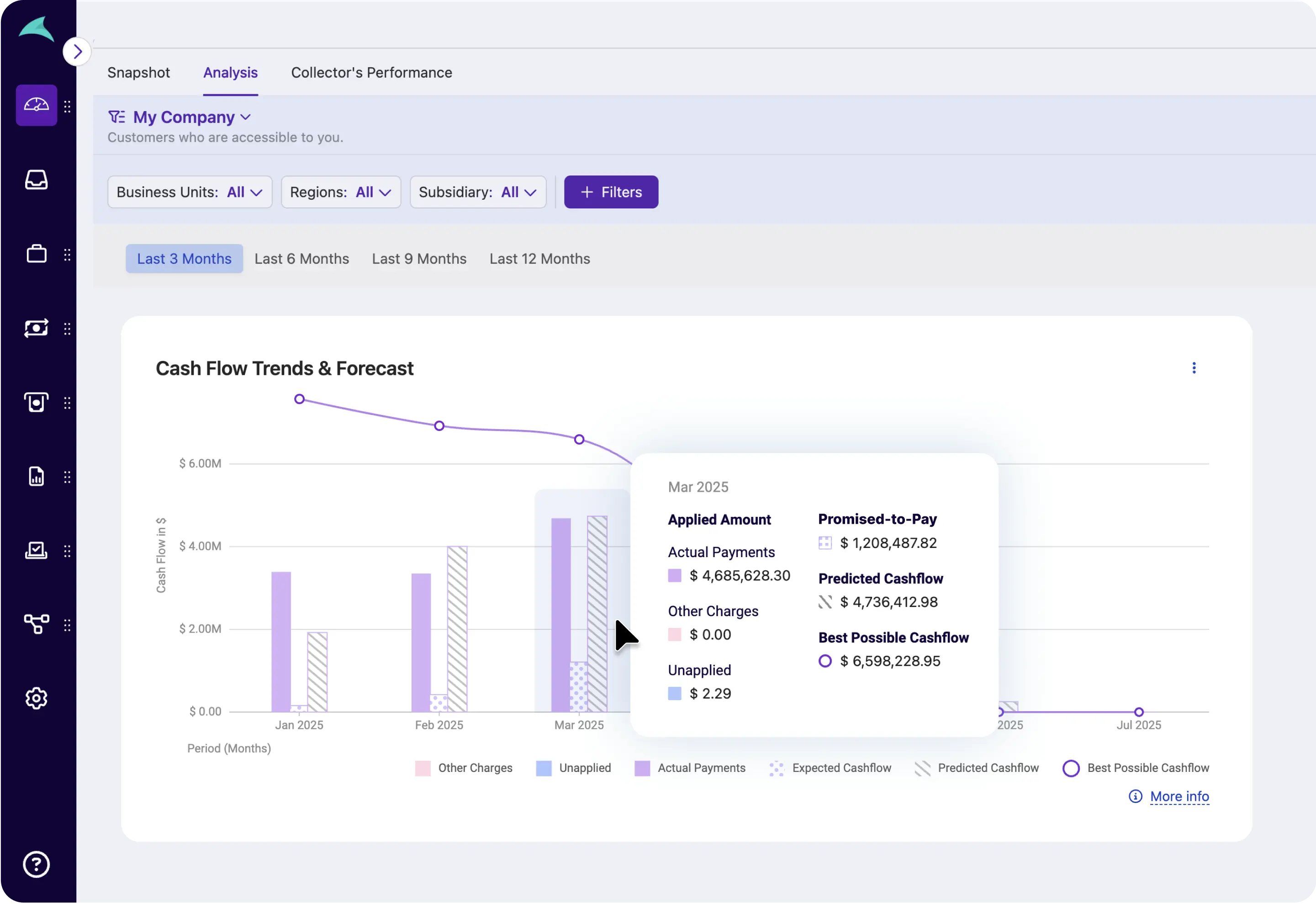
2. ADP and DSO Trend Analysis: View them as KPIs Operational Levers
Average Days to Pay and Average Delay in Payments (ADP) are also critical metrics to track and analyze over time. By tracking how long it actually takes to settle invoices and how often payments run past due dates, you can uncover inefficiencies, cash flow gaps, or strained customer relationships.
DSO is more than just a benchmark. It’s a reflection of how well you’re converting booked sales into cash. According to JP Morgan, the average B2B DSO across industries ranges from 40 to 55 days.
For example: In healthcare companies, where reimbursement cycles vary across private payers and government programs; static DSO metrics can often hide structural delays.
A payer’s average payment window moving from 45 to 60 days may go unnoticed, until cash availability tightens.
With real-time DSO segmented by payer, by procedure, or by region; teams can address the root cause: Is it missing documentation? New policy delays? Billing errors?
Finance teams can then take decisive action before revenue slips downstream into disputes or bad debt write-offs.
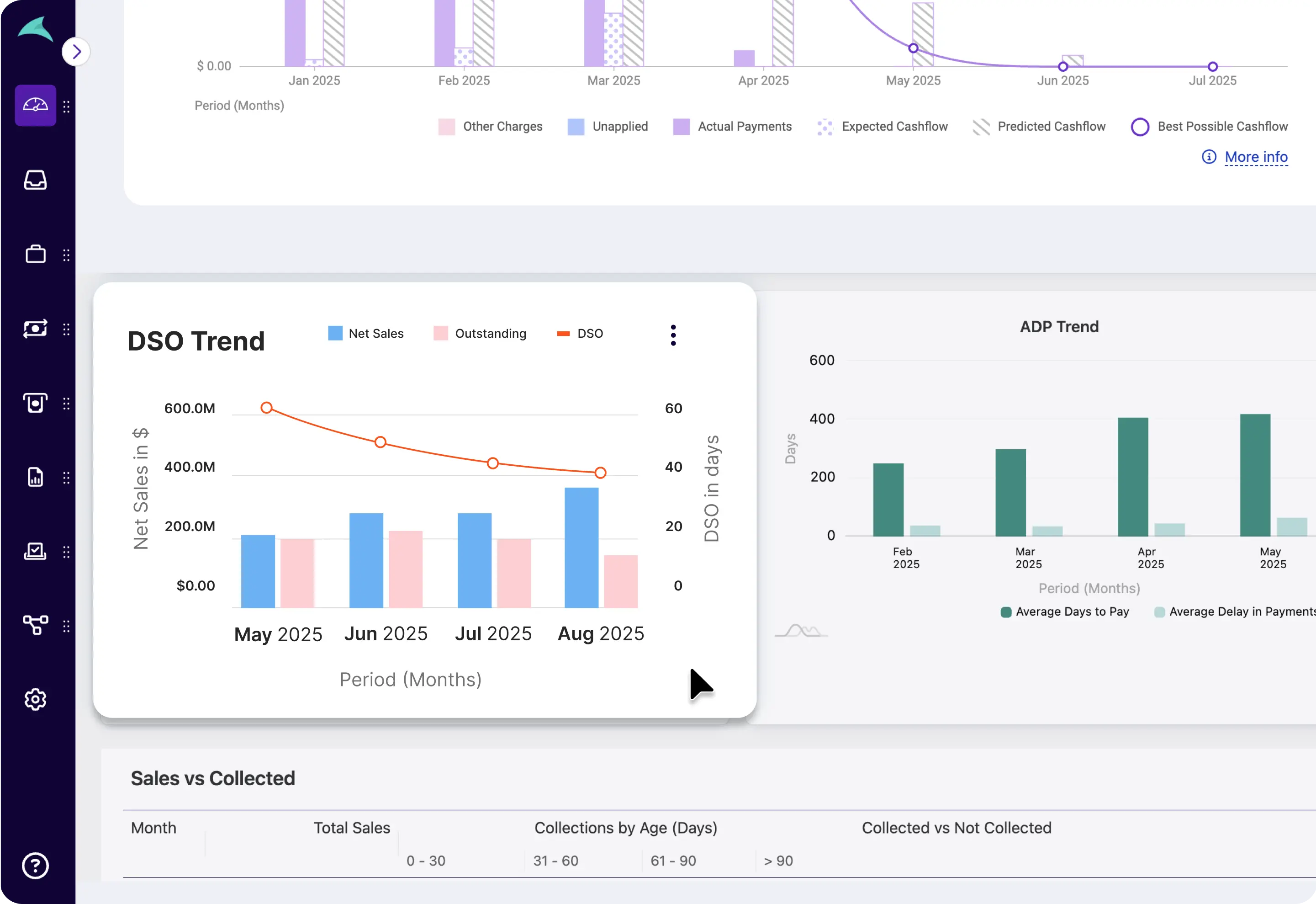
Bonus: Check out our DSO Benchmarks Calculator and Dashboard to - tailored to your specific industry - and uncover opportunities to reduce DSO, optimize working capital, and accelerate cash conversion cycles.
3. Collector Performance Analytics: Go Beyond Activity Metrics
Most AR reporting spotlights different collector activities: emails sent, accounts touched, calls made.
But volume ≠ value.
What you need is complete visibility into what’s actually working.
Advanced AR analytics should help you answer the following questions:
- Which collectors are converting riskier accounts to cash?
- Who resolves disputes the fastest?
- Which communication channels lead to the fastest payments?
- How long does each collector take to close a past-due account?
Some collectors outperform others not because they send more reminders; but because they personalize outreach, collaborate internally, and escalate issues tactfully.
Recognizing these individual behaviors allows you to replicate best practices and reassign complex accounts to the right people within your AR teams.
For example: In the manufacturing industry, a collector managing high-value distributor accounts may be more effective by coordinating with the logistics and supply chain teams to resolve delivery or quality disputes that often delay payments.
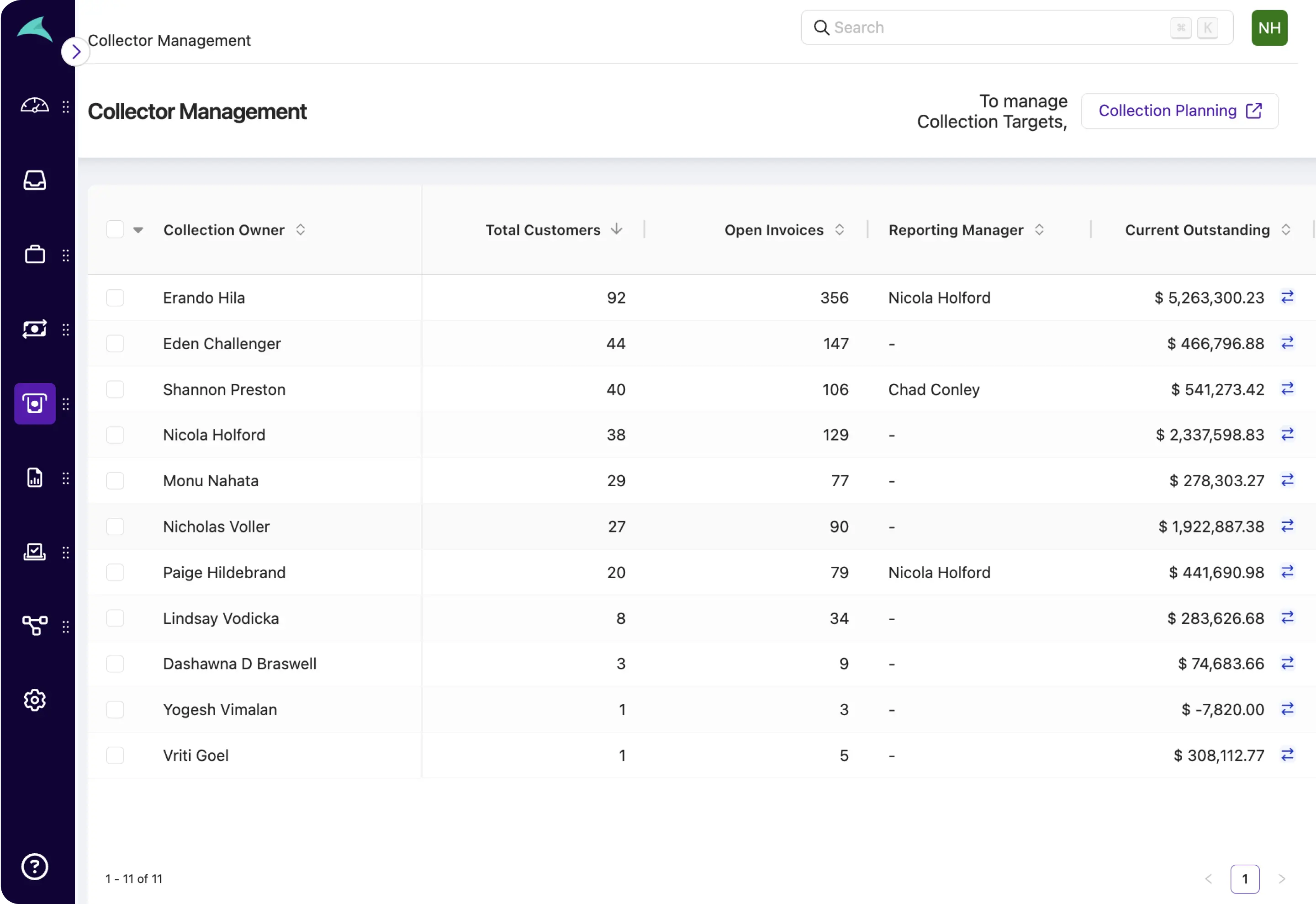
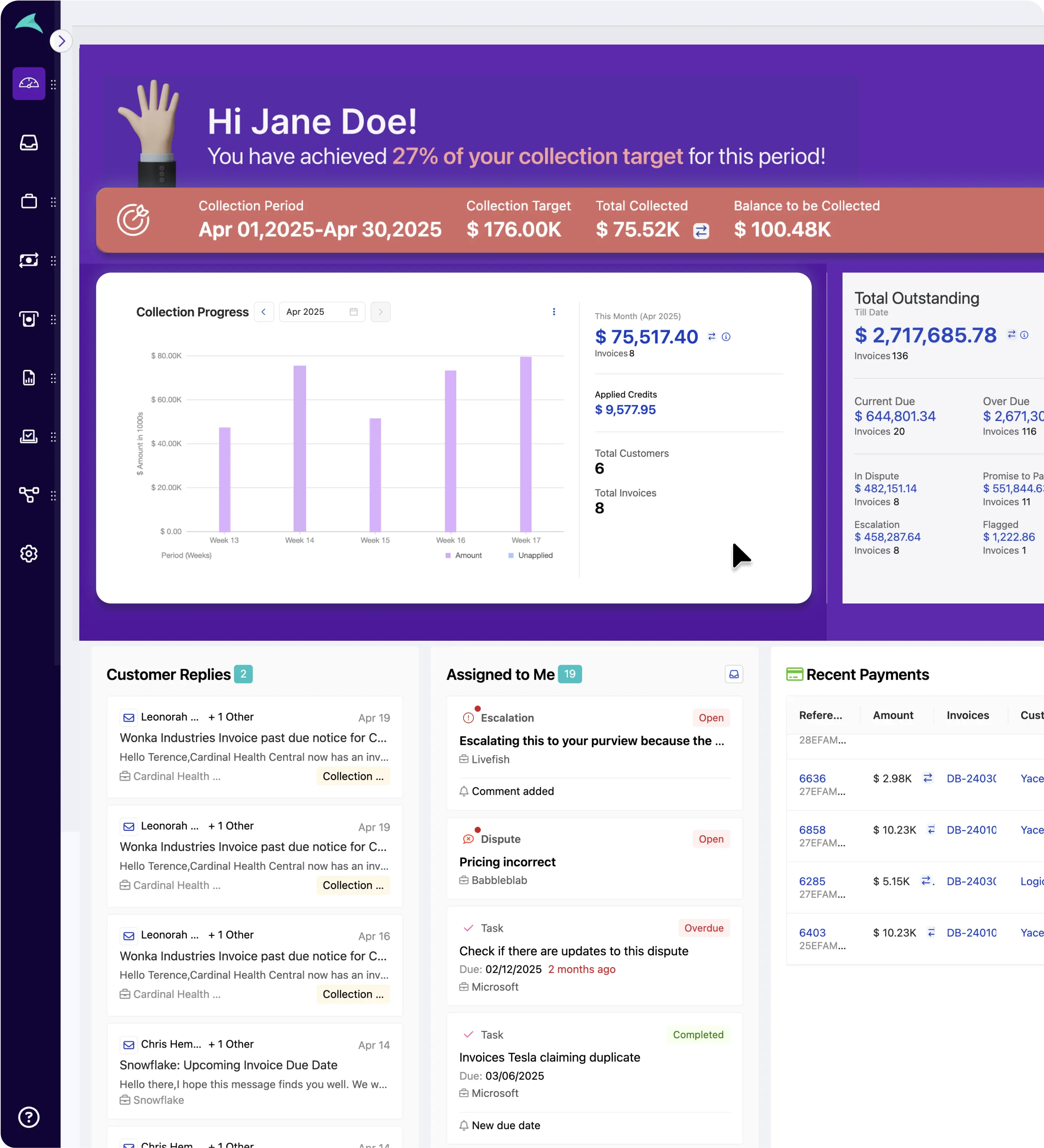
4. Dunning Automation Reporting: Adapt to Unique Customer Behavior
Sending a one-size-fits-all reminder every 3 days might check a box. But; it doesn’t move the needle. Smart dunning adapts to payment history, customer tier, and captured responsiveness.
It also learns what works by comparing and analyzing message types, timing, tone, intent, and follow-up combinations to maximize collection outcomes.
For example: In the energy and utilities industry, large commercial customers may have seasonal payment fluctuations tied to peak usage cycles.
An intelligent dunning system can adjust its reminder cadence for industrial clients with historically predictable late payments during off-peak months. This can be enabled using personalized, relationship-based follow-ups instead of rigid reminder schedules.
The result? Improved recovery rates and stronger customer relationships.
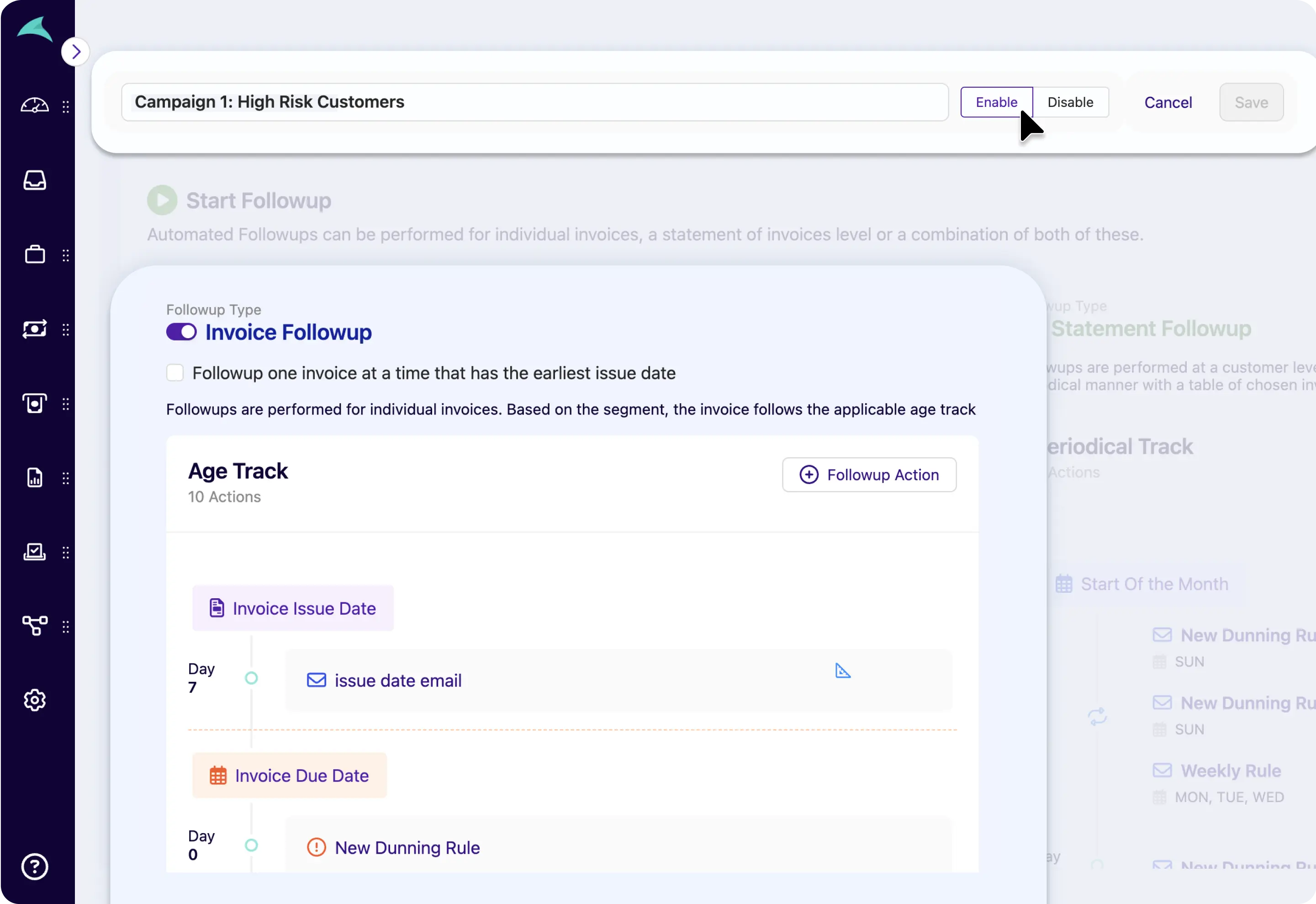
5. Real-Time AR Overview Dashboard: Connect All the Dots
The most impactful shift you can make is moving from siloed reports to a unified view of your end-to-end AR processes. This single source of truth and control should enable you to:
- Monitor payment predictions and real-time aging
- See dispute trends across account types
- Evaluate collector performance; as a team and at an individual level
- Track effectiveness of dunning campaigns
- Identify systemic risks across customer segments
For example: In global supply chain operations, such unified visibility helps isolate whether delays are due to regional disputes, missing documentation, or external disruptions like customs delays.
Instead of waiting for Finance Ops to pull fragmented reports, CFOs and AR leaders can act on what’s happening in the moment - today.
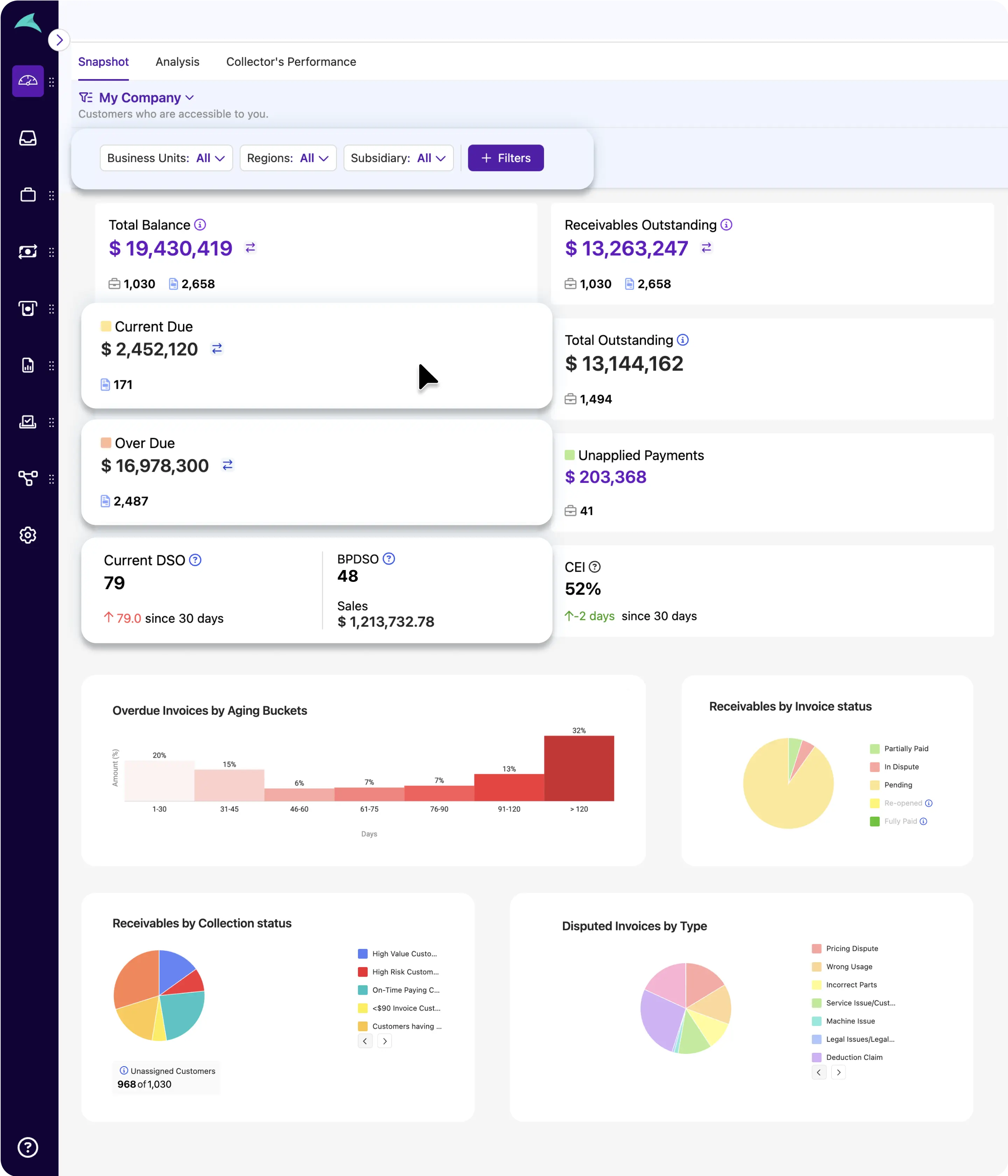
Why This Shift Matters: Now More than Ever
This isn’t about modernizing for modernization’s sake. It’s about adapting to survive, and thrive in a financial environment that’s more dynamic than ever.
Here’s how real-time AR reporting and analytics can help you:
1. Improved Liquidity Planning Accuracy: Daily insights into cash inflows by likelihood, enabling smarter treasury decisions, and reducing reliance on credit lines
2. Increased Working Capital Efficiency: Faster collections driven by targeted follow-ups and predictive risk insights reduce locked-up cash
3. Higher Revenue Confidence: Better alignment with Sales and Customer Success teams to prevent churn, manage escalations, and turn AR into a revenue retention lever
4. Heightened Board and Investor Trust: Data-backed narratives around DSO reduction, collection efficiency, and predictability of cash flows build credibility.
The Financially Intelligent AR Team: No Longer a Pipedream
An enterprise with best-in-class AR reporting and analytics isn’t just automated. It’s intelligent, predictive, and aligned across functions. Here’s what that can look like for you:
- As the CFO; you open up a dashboard and see predicted cash inflows for the next 30 days, broken down by risk tiers and confidence scores
- AR Managers know which accounts to prioritize today because aging reports are layered with behavioral risk signals
- Collectors are assigned accounts based on historical conversion data, and not based on round-robin alignments
- Dunning emails are optimized by performance data, not guesswork with versioned follow-ups for different customer segments
- Any deviation in DSO or dispute trends trigger automated alerts, not next month’s variance report
- Sales and Customer Success have shared and complete context on delayed accounts, reducing internal friction and improving the overall customer experience
This is what it means to run AR like a strategic command center, not a back-office support function that flies under the radar.
The Strategic CFO’s Edge: Today and Tomorrow
In 2025, you can’t afford to fly blind, or even delayed.
If your AR teams are banking on yesterday’s data; they will always be stuck in a reactionary infinity loop. You need real-time, actionable AR intelligence to outmaneuver uncertainty. This will enable your teams to collect faster, forecast better, and protect margins proactively.
Also: Transforming financial reporting isn’t about populating and firing up dashboards alone.
It’s about reclaiming control over cash, driving operational alignment, and earning trust in every financial conversation, right from the AR desk to the boardroom.
So; the next time you review your financial reporting systems, don’t just ask what they track.
Instead ask: Can they help us act faster, forecast sharper, and protect our cash, before the quarter ends?
And; we can empower you to do just that. Schedule a free personalized consultation to learn how you too can embark on the path to transform your financial AR reporting - today.



.png)
.webp)


.webp)













.webp)




.webp)
.webp)

.webp)
.webp)
.webp)
.webp)